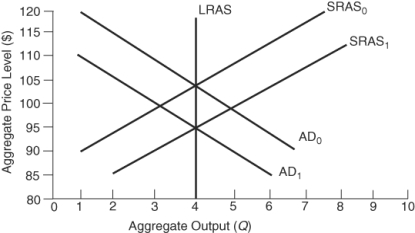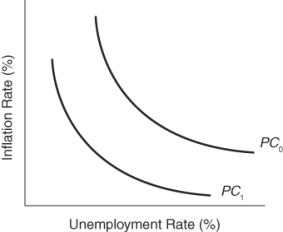Correct Answer

verified
Correct Answer
verified
True/False
By paying an efficiency wage, employers give employees an incentive to shirk their duties.
Correct Answer

verified
Correct Answer
verified
Multiple Choice
(Figure: Aggregate Supply and Demand Shifts) The economy is originally at its long-run equilibrium, SRAS0 and AD0. Government policymakers signal that they intend to reduce aggregate demand from AD0 to AD1. If we assume that individuals have rational expectations, then the speed of the shift from SRAS0 to SRAS1 will happen: 
A) almost immediately.
B) after a long lag.
C) only after the government finishes fully implementing its policy.
D) too slowly to affect the price level.
Correct Answer

verified
Correct Answer
verified
Multiple Choice
Adaptive expectations theory describes the use of _____ to form expectations of inflation.
A) all publicly available information
B) expected future policies
C) present data
D) past rates of inflation only
Correct Answer

verified
Correct Answer
verified
Multiple Choice
Using the equation for the Phillips curve, suppose that nominal wages increased by 5% and the inflation rate was 3%. What was the rate of increase in labor productivity?
A) 2%
B) 5%
C) 8%
D) 15%
Correct Answer

verified
Correct Answer
verified
Multiple Choice
According to the equation for the Phillips curve, if wages rise by 2%, inflation:
A) must also rise by 2%.
B) will be zero if productivity increases by 2%.
C) will be zero if productivity increases by more than 2%.
D) will be zero if productivity falls by 2%.
Correct Answer

verified
B
Correct Answer
verified
Multiple Choice
Monetized debt:
A) is paid for by a decrease in the money supply.
B) results in appreciation of the dollar.
C) will result in a weaker dollar if foreigners hold fewer dollars.
D) increases the burden of existing debt.
Correct Answer

verified
C
Correct Answer
verified
Multiple Choice
If inflationary expectations fall:
A) there is a movement down along the Phillips curve.
B) the Phillips curve shifts outward.
C) the Phillips curve shifts inward.
D) there is a movement up along the Phillips curve.
Correct Answer

verified
Correct Answer
verified
Multiple Choice
Suppose the Federal Reserve announces that its policy will increase the supply of money next year. This announcement can be expected to:
A) increase unemployment.
B) shift the Phillips curve to the right.
C) reduce tax revenues.
D) shift the Phillips curve to the left.
Correct Answer

verified
Correct Answer
verified
Multiple Choice
Which of these helps explain jobless recoveries?
A) U.S. productivity has been decreasing.
B) Firms have been unwilling to hire temporary workers until they know the demand for their product has reached prerecession levels.
C) Firms are not willing to pay for overtime until the demand for their product recovers.
D) Increased technology has enabled companies to use fewer workers.
Correct Answer

verified
Correct Answer
verified
True/False
If wages rise by 3% and productivity rises by 2%, then prices can be expected to rise by 5%.
Correct Answer

verified
Correct Answer
verified
True/False
The main practical difference between the rational expectations and adaptive expectations theories is the speed of adjustment in the economy.
Correct Answer

verified
Correct Answer
verified
Multiple Choice
One of the primary assumptions of the rational expectations model is that:
A) labor and product markets are highly competitive.
B) people expect others to behave irrationally.
C) labor markets exhibit short-term stickiness.
D) prices do not adjust quickly to expansionary policies.
Correct Answer

verified
Correct Answer
verified
Multiple Choice
(Figure: Understanding Phillips Curves) What is the natural rate of unemployment associated with Phillips curve PCb? 
A) zero
B) 3%
C) 4%
D) 5%
Correct Answer

verified
Correct Answer
verified
True/False
If policymakers want to keep unemployment below the natural rate, they must continually increase aggregate demand so that inflation is always greater than anticipated, thereby setting up an inflationary spiral.
Correct Answer

verified
Correct Answer
verified
True/False
The adjustable-rate mortgage was the standard type before the early 2000s.
Correct Answer

verified
Correct Answer
verified
Multiple Choice
Suppose policymakers want to keep the unemployment rate below its natural rate by increasing demand. A consequence of this policy would be:
A) an increase in aggregate supply.
B) a stable Phillips curve.
C) increasing structural unemployment.
D) accelerating inflation.
Correct Answer

verified
Correct Answer
verified
Multiple Choice
Subprime mortgages were loans made to borrowers with _____ credit and who, as a result, were charged _____ interest rates.
A) excellent; low
B) excellent; high
C) poor; low
D) poor; high
Correct Answer

verified
D
Correct Answer
verified
Multiple Choice
Which of these is NOT a way that hiring practices have changed over the past few decades?
A) Firms use more temporary workers.
B) Firms are more likely to add overtime shifts for permanent employees.
C) Firms are more likely to use just-in-time hiring practices.
D) Firms are more likely to hire permanent employees.
Correct Answer

verified
Correct Answer
verified
Multiple Choice
(Figure: Understanding Phillips Curves Shifts 2) What would cause an outward shift from Phillips curve PC1 to Phillips curve PC0? 
A) a decrease in the expected inflation rate
B) an increase in the expected inflation rate
C) a decrease in the natural rate of unemployment
D) an increase in the natural rate of unemployment
Correct Answer

verified
Correct Answer
verified
Showing 1 - 20 of 265
Related Exams